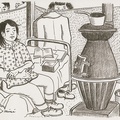In this short essay I’d like to describe a new manuscript in progress, tentatively titled Japanese American Resettlement Through the Lens. My co-author on this piece is my former student and now colleague, Kenichiro Shimada, from the University of Maryland.
Our starting point is that fact that various on-line web sites have revolutionized access to and the circulation of war-time photographs of Japanese Americans. In particular, the complementary collections that are available on the “Japanese American Relocation Digital Archive” or JARDA (http://jarda.cdlib.org/ ) and the University of California’s “Digital Library” project (http://www.oac.cdlib.org/) are easy to use and thus very suitable for students, scholars, and members of the general public, alike.
Bibliographic work, however, indicate that there is very little published literature about how, why, and by exactly whom, most of these photographs were generated. What scholarship exists revolves mostly around select artists such as Dorothea Lange, Ansel Adams, and Toyo Miyatake. Most commentary also revolves around the aesthetic dimensions of each individual photographer’s pictures.
Our intention with, Japanese American Resettlement Through the Lens, is to focus on the War Relocation Authority’s resettlement photographs taken largely between 1943 and 1945. This time frame entails an institutional approach to the JA war photographs, insofar as the mission, the method of production, selection, and distribution of these shots were all carried out under explicit directives issued by the War Relocation Authority. Because the archival record on these matters is fragmented, we have also highlighted the work and commentary of Hikaru Iwasaki—the only full-time WRA photographer who is still alive and who can tell us a great deal about how all of the WRA’s photo work was done.
In the final analysis, this approach allows a clearer understanding of the inherent strengths and weaknesses of the tens of thousands of WRA photographs that are presently held in the National Archives and Records Administration and that are now on-line. This is because, although we can discern differences in the styles of individual photographers, the discussion of the politics and aesthetics of individual artists tends to disguise the extent to which the War Relocation Authority’s goals very much determined the kinds images that are now available to us.
In essence, the WRA promoted photographic images that highlighted freedom, opportunity, and the blessings of one’s own home as compared to the constraints of life in the WRA camps.
http://content.cdlib.org/ark:/13030/tf6779p26q/
Thus, one of the key reasons that the WRA had photos along these lines taken was that the Authority wanted to convince “loyal” Japanese Americans to leave the camps before the war had actually ended.
Although we have studied the resettlement photos taken between 1943 and 1945 as a way to analyze and critique the WRA’s policies, there are plenty of other research opportunities that our research suggests.
One that is only partially carried out is research on the trajectories of the different photographers that led them into WRA work. There are a number of different and distinctive paths at play here including the independent photographers (e.g., Ansel Adams; Toyo Miyatake); the documentarians hired by the WRA (e.g., Dorothea Lange; Russell Lee, both of whom worked for Roy Stryker in the Farm Security Administration during the 1930s); the “reports officers” who worked in specific WRA camps (e.g., Joe McClelland, the Reports Officer at Camp Amache in Colorado); and the WRA’s Photographic Unit staff (e.g., Tom Parker; Hikaru Iwasaki) who worked for the WRA’s official Photographic Unit located in Denver, Colorado, between 1943 and 1945.
We also argue that, just because the WRA photographs are biased, doesn’t mean that we can’t re-analyze these same photographs in order to construct alternative hypotheses about the overall nature and impact of JA resettlement.*
For example, although the WRA wanted to promote occupational opportunities for Japanese Americans if and when they left camp, the text of many of the official photos indicates that many educated Nisei faced a period of downward mobility, especially in terms of their initial employment experiences.
http://content.cdlib.org/ark:/13030/ft509nb2p1/
Also, there are many indications that many Japanese American families relied upon mutual aid in order to survive the early period of resettlement. This, of course, went against the WRA’s dictums that JAs would be better off if they dispersed, avoided their ethnic compatriots, and did their best to assimilate into the mainstream society.
http://content.cdlib.org/ark:/13030/ft4c60064p/
These themes are best taken as hypotheses at this point, but we put them forward as topics that could be studied through the WRA’s own photographs (even though neither one has to do with outcomes that the Authority recognized, let alone endorsed).
In sum, even though the WRA photographs are inherently biased, once we understand this we are in a good position to re-appropriate these unique historical images for our own purposes, today.
NOTES:
*This is precisely what I’ve argued in terms of considering documents in the “Japanese American Resettlement Study,” a University of California research project. That is, JERS (Japanese American Evacuation and Resettlement Study) employees such as Richard Nishimoto, an Issei man, and Tamie Tsuchiyama, a Nisei woman, certainly had their own biases in terms of writing up their reports. Once we know who they were, and how they did their work, however, we can control for these biases, even as we re-deploy their data for our own purposes today. I used Nishimoto’s research, for example, to assess popular resistance in the Poston I camp. This was definitely not something that Nishimoto, himself, was trying to study per se.
See my study, which anthologizes three of Nishimoto’s ethnographic reports: Inside An American Concentration Camp (University of Arizona Press, 1995).
* Professor Lane Ryo Hirabayashi developed this essay from a presentation “Japanese American Resettlement: Through the Lens” at the Center for Pacific and American Studies at the University of Tokyo on November 15, 2006.
© 2007 Lane Ryo Hirabayashi





